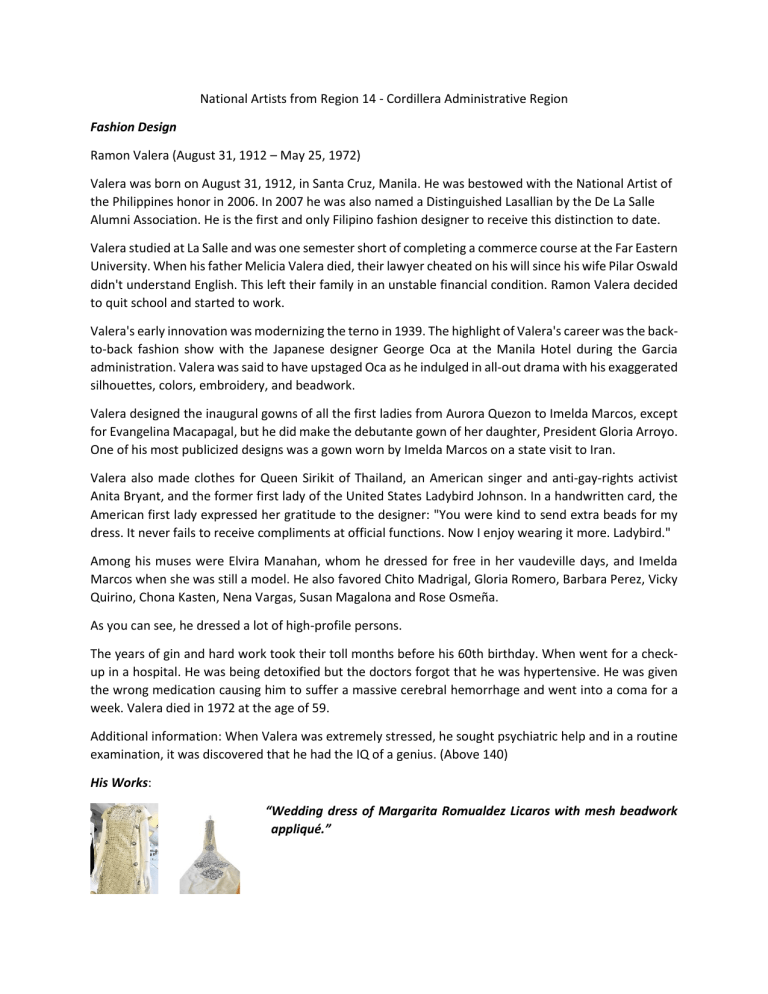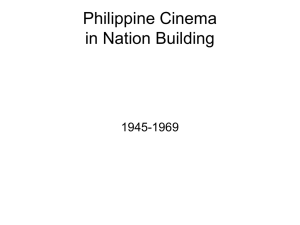
National Artists from Region 14 - Cordillera Administrative Region Fashion Design Ramon Valera (August 31, 1912 – May 25, 1972) Valera was born on August 31, 1912, in Santa Cruz, Manila. He was bestowed with the National Artist of the Philippines honor in 2006. In 2007 he was also named a Distinguished Lasallian by the De La Salle Alumni Association. He is the first and only Filipino fashion designer to receive this distinction to date. Valera studied at La Salle and was one semester short of completing a commerce course at the Far Eastern University. When his father Melicia Valera died, their lawyer cheated on his will since his wife Pilar Oswald didn't understand English. This left their family in an unstable financial condition. Ramon Valera decided to quit school and started to work. Valera's early innovation was modernizing the terno in 1939. The highlight of Valera's career was the backto-back fashion show with the Japanese designer George Oca at the Manila Hotel during the Garcia administration. Valera was said to have upstaged Oca as he indulged in all-out drama with his exaggerated silhouettes, colors, embroidery, and beadwork. Valera designed the inaugural gowns of all the first ladies from Aurora Quezon to Imelda Marcos, except for Evangelina Macapagal, but he did make the debutante gown of her daughter, President Gloria Arroyo. One of his most publicized designs was a gown worn by Imelda Marcos on a state visit to Iran. Valera also made clothes for Queen Sirikit of Thailand, an American singer and anti-gay-rights activist Anita Bryant, and the former first lady of the United States Ladybird Johnson. In a handwritten card, the American first lady expressed her gratitude to the designer: "You were kind to send extra beads for my dress. It never fails to receive compliments at official functions. Now I enjoy wearing it more. Ladybird." Among his muses were Elvira Manahan, whom he dressed for free in her vaudeville days, and Imelda Marcos when she was still a model. He also favored Chito Madrigal, Gloria Romero, Barbara Perez, Vicky Quirino, Chona Kasten, Nena Vargas, Susan Magalona and Rose Osmeña. As you can see, he dressed a lot of high-profile persons. The years of gin and hard work took their toll months before his 60th birthday. When went for a checkup in a hospital. He was being detoxified but the doctors forgot that he was hypertensive. He was given the wrong medication causing him to suffer a massive cerebral hemorrhage and went into a coma for a week. Valera died in 1972 at the age of 59. Additional information: When Valera was extremely stressed, he sought psychiatric help and in a routine examination, it was discovered that he had the IQ of a genius. (Above 140) His Works: and “Wedding dress of Margarita Romualdez Licaros with mesh beadwork appliqué.” The Terno worn by Gloria Romero, 1960, with embroidery in braid and checkerboard designs. Dress of Consuelo “Chito” Madrigal then Rustan’s chair and CEO Zenaida Tantoco’s debutante dress. (Behind, as worn by the 18-year-old.) Film Lamberto V. Avellana (February 12, 1915 - April 25, 1991) Lamberto V. Avellana was born on February 12, 1915, in Bontoc Mountain Province. Avellana studied at the Ateneo de Manila, where he developed what turned out to be a lifelong interest in the theater. He taught at the Ateneo after graduation and married his teenage sweetheart Daisy Hontiveros, an actress who eventually also became a National Artist in 1999. In 1976, Avellana was named by President Ferdinand Marcos as the first National Artist of the Philippines for Film. He directed more than 70 films in his six-decade career. His most famous works are “Anak Dalita” (1956) and “Badjao" (1957), which both attained international acclaim and stood as his most prominent works despite budgetary limitations that hampered the post-war Filipino film industry. "Anak Dalita" was named Best Film at the 1956 Asia-Pacific Film Festival, it was a realistic portrayal of poverty-stricken Filipinos coping with the aftermath of World War II. "Badjao" on the other hand was a love-story among the sea-dwelling Badjaos, an indigenous Filipino people hailing from Mindanao. He directed the first Philippine film ever shown at the Cannes International Film Festival titled “Kandelerong Pilak.” He was also a founder of the first Philippine theater group name “Barangay Theater Guild” (1939). He died on April 25, 1991, at the age of 76. His Works: Sakay (1939) The story of the life and death of Macario Sakay, the President of the Tagalog Republic and one of the last Filipino generals to surrender to the American forces during the American colonial period. Badjao (1957) A story about a tribal chief's son that falls in love with the niece of his arch-rival. The boy is willing to leave his tribe for his love, but the girl's father conspires to keep them apart. Anak Dalita (1956) It is a tragedy story about a war hero that meets a prostitute in the postwar ruins of Manila. National Artist from Region 5 – Bicol Region Dance Ramon Arevalo Obusan (June 16, 1938 – December 21, 2006) Ramon Arevalo Obusan was born on the 16th of July 1938 in Legazpi City. He was a Filipino dancer, choreographer, stage designer and artistic director. Obusan is credited for his work in promoting Philippine traditional dance and cultural work that broadened and deepened the understanding Filipinos on its own cultural life and expressions. Obusan wrote Dances of the Philippines, a compilation of all the research he has done on Philippine folk and ritual dances. He also has the largest collection of videos on Philippine dances. He founded Ramon Obusan Folkloric Group in 1972, which had affected cultural and diplomatic exchanges using the multifarious aspects and dimensions of the art of dance. In 1992 he received the Patnubay ng Kalinangan award by the City of Manila and in May 2006, he became a National Artist of the Philippines. He died on December 21, 2006, due to cardio-pulmonary arrest. His Works: Noon Po sa Amin, tableaux of Philippine History in song, drama, and dance Water, Fire and Life, Philippine Dances and Music--A Celebration of Life Film. Saludo sa Sentenyal Film Catalino Ortiz Brocka (April 3, 1939 – May 22, 1991) Catalino Ortiz Brocka was born on Pilar, Sorsogon on April 3, 1939. He grew up and lived in San Jose, Nueva Ecija and graduated from Nueva Ecija High School in 1956. He is widely regarded as one of the most influential and significant filmmakers in the history of Philippine cinema. He co-founded the organization Concerned Artists of the Philippines (CAP) which is dedicated to helping artists address issues confronting the country, and the Free the Artist Movement. He was also a member of the Coalition for the Restoration of Democracy. He directed landmark films such as Tinimbang Ka Ngunit Kulang (1974), Maynila sa mga Kuko ng Liwanag (1975), Insiang (1976), Bayan Ko: Kapit sa Patalim (1984), and Orapronobis (1989). He espoused the term “freedom of expression” in the Philippine Constitution. On May 22, 1991, he died from a car accident. In 1997, Brocka was proclaimed as a National Artist for Film and Broadcast Arts. His Works: Tinimbang ka Ngunit Kulang (1974) This landmark film is considered by many to be one of the most important in Philippine cinema. The son of a wealthy man, Junior has everything he could possibly want. But the emptiness of his extravagant lifestyle and the hypocrisy of the town's so-called leading citizens weigh heavily on him, pushing him to reach out to the village outcasts. Maynila sa mga kuko ng liwanag (1975) the It is a story about a simple fisher man from a province who travels to manila to find woman he loves only to be immersed in the city lifestyle and get involved with its inhabitants experiencing extreme poverty, hard luck, and the overbearing need to grind for daily sustention. While the man relentlessly searches for the woman he loves, the city changes him little by little, becoming like an animal doomed to live only for survival in a wild jungle with no way out. Insiang (1976) It is a story of revenge of a woman for being treated badly by those people around her. Manuel Conde (October 9, 1915 – August 11, 1985) Born on October 9, 1915, in Manuel Pabustan Urbano, Manuel Conde grew up and studied in Daet, Camarines Norte. Through the more than forty films he created from 1940 to 1963, Manuel Conde contributed in no small measure to the indigenization of the cinema, specifically: by assigning it a history and culture of its own; by revitalizing folk culture with urgent issues, fresh themes and new techniques; by depicting and critiquing Filipino customs, values and traditions according to the needs of the present; by employing and at the same time innovating on the traditional cinematic genres of his time; and by opening the local cinema to the world. His first film was Mahiwagang Biyolin in 1935. He made almost three dozen films under LVN Pictures as a contract star. He later put up his own movie company, Manuel Conde Pictures, in 1947 which produced classic films, notably the Juan Tamad series and the internationally acclaimed Genghis Khan in 1950. Genghis Khan was the first Filipino film to be acclaimed at an international film festival in Venice in 1952. His Juan Tamad Goes to Congress is considered the best Filipino satire ever filmed. Manuel Conde died in 1985 in Manila, Philippines and in 2009 he became a National Artist for Cinema His Works: Ibong Adarna (1941) It is a film adaptation of the epic poem of the same name. It tells the story of an ailing king who sent his three sons to search for the Ibong Adarna "Adarna bird" as the only cure to his illness and as a reward of whoever catches the bird and bring to him will inherit the throne. Each of the princes went out on their own expedition. Juan Tamad (1947) ` It is a story about a super lazy boy. It is considered by many a laughfterpiece. Siete Infantes de Lara (1950) The story revolves around a family feud, an escalating tit-for-tat cycle of revenge, Arts and Crafts Region 14 - Cordillera Administrative Region Cordillera Weaves • • Kalinga Textile – Weavers of Kalinga Textile use indigenous raw materials from banana, cogon, abaca and maguey and braid them with polyester or cotton textile. Labba basket - Labba is the antique Kalinga storage basket for carrying and storing rice or vegetables Additional Information - In the Cordillera, the use of cloth is involved in life from birth to death, in sickness and health. A baby is cocooned in cloth. The sick are wrapped and healed in it. Couples are clasped in it and in death, one is buried in it. Identity is defined when the members of a group make and wear clothing that distinguishes them from others. Dressing styles indicate different ethnic origins. As an art form, textiles are embedded in all aspects of life from day-to-day situations to the performance of rituals. Ling Ling o - A centuries-old symbol of fertility and luck since the Metal Age of the Philippines from 5001000 AD. It is handmade by the Ifugao in the Corderilla mountains. Traditional Tattoo The ancient art of tattooing is inspired by tradition throughout the Cordilleras. One of the most famous of all tattoo artisans is the great Maria Oggay, more popularly known to the world by her native name Apo “Whang-od.” She lives in Buscalan, Tinglayan, Kalinga, and accommodates visitors daily tapping on skin and marking her patrons with her amazing art. Apo Whang-od is also known as “the last and oldest mambabatok” in Kalinga and is a part of the Butbut tribe. Apo Whang-od’s ink is composed of the mixture of charcoal and water that is tapped into the skin through a thorn end of a lemon or pomelo tree. Apo Whang-od’s hand-tapped tattoo technique—called batok—dates back to thousand years and is said to be more painful that the machine tattooing system. Ginaspala wanes – A belt worn by married women of Bontoc and Kankana-y with inawin designs composed of continous zigzag pattern. Region 5 – Bicol Region Among the arts and crafts of Bicol Region Include: • • • • • • Baskets Bags Slippers Coin Purses Sleeping mats Hats That are made from abaca and raffia fibers. A lot of historical churches are also located in Bicol Region such as: • • • The old stone church of paracale Bato Church Daraga Church


